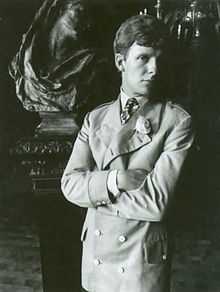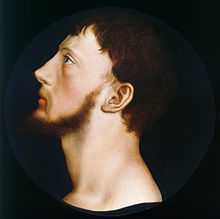Christopher Gibbs

Christopher Henry Gibbs (born 29 July 1938)[1] is a British antiques dealer and collector who was also an influential figure in men's fashion and interior design in 1960s London. He has been credited with inventing Swinging London, and has been called the "King of Chelsea" and "London's most famous antiques dealer".[2] The New York Times described him as a "man of infinite taste, judgment and experience, the one who introduced a whole generation to the distressed bohemian style of interior design."[3]
Early life and education
Gibbs is the fifth son of Hon. Sir Geoffrey Cokayne Gibbs KCMG and his wife Helen Margaret Leslie CBE, and the grandson of Herbert Gibbs, 1st Baron Hunsdon of Hunsdon. His elder brother is the financier Sir Roger Gibbs. He was educated at Eton College, from which he was expelled "for being generally totally impossible",[4] Stanbridge Earls School and the University of Poitiers.[1]
Swinging London

A style leader in 1960s London, Gibbs is credited with fellow Old Etonian Robert Fraser with inventing "Swinging London".[5] He has been said to be the first man to wear flared trousers in 1961, and was ordering flower print shirts by 1964. He was an editor of the shopping guide in the quarterly Men in Vogue, the first male edition of the magazine produced between 1965 and 1970, which was closely associated with the "Peacock revolution" in English men's fashion in the 1960s. His style has been described as a kind of "louche dandyism",[6] while others have described him as a latter-day Beau Brummell.[7]
At the same time, Gibbs was running his own antiques business, which he had started in 1958, making regular trips to Morocco to acquire stock. He brought back Moroccan brass lamps, carpets, soft furnishings and other things that came to characterise the "hippie look".[8]
The Rolling Stones
Gibbs was a friend of the Rolling Stones and his upper-class background was of interest to Mick Jagger, whose origins were more modest. It was at one of Gibbs' Cheyne Walk, Chelsea, dinner parties that Jagger whispered to the fashion designer Michael Fish, "I'm here to learn how to be a gentleman".[8] In 1967, Gibbs was at Keith Richards's country house, Redlands, in West Wittering, when Richards, Jagger and Marianne Faithfull were all arrested (and Jagger subsequently imprisoned) for possession of illegal drugs.[2][9] And in 1968, Gibbs introduced Prince Rupert Loewenstein, then working in London as a merchant banker, to Jagger.[10] Loewenstein went on to became the Stones' business manager until 2007.[11]
Gibbs was the set designer on the 1970 film Performance, directed by Donald Cammell and Nicolas Roeg and starring James Fox and Mick Jagger. He is godfather to one of Jagger's children.[12]
Davington Priory

In 1972, Gibbs bought Davington Priory, a former Benedictine nunnery Davington, Kent, built in 1153. It was there that David Litvinoff lived from 1972 until 1975 when he committed suicide through an overdose of pills.[13] Gibbs sold Davington Priory in 1982. It is now owned by Bob Geldof.[14]
A "long lost masterpiece"

In 2006, a painting Gibbs had bought in 1974 for £2,800 was put up for sale by Sotheby's with an estimate of £2–3 million. It had taken experts, led by Gibbs' friend Sir Roy Strong, 30 years to complete the authentication of the work as "a long lost masterpiece" by Hans Holbein of Thomas Wyatt the Younger.[2] The painting failed to sell after it was leaked that Tate Britain doubted its authenticity.[15] In 2007 it appeared for sale at $10 million on a dealer's stand at the Maastricht Art Fair[16] after the attribution to Holbein was accepted by the TEFAF vetting committee.[17]
Charity work
Gibbs played a key role in persuading his friend John Paul Getty, Jr. to donate £40 million to the British National Gallery.[12] After Getty's death in 2003, Gibbs became chairman of the J. Paul Getty Jr. Charitable Trust, set up to manage Getty's estate.[18] He is also a trustee of the American Friends of the National Gallery.[1]
Later life
In 2000, Gibbs reluctantly sold the Manor House at Clifton Hampden, Oxfordshire, a house that had been built for his family in the 1840s. Christie's auctioned off the contents over two days.[19] The sale showed his eclectic tastes: lots included a dining table supposedly made from one of the first pieces of mahogany brought to England from the New World in the 17th century, and a portrait of Cornish eccentric John Nichols Thom.[19] In 2005 or 2006, he moved to Tangier, where he still lives as of 2014. According to a friend, "He has a house on 14 acres in Tangier next door to the king" and "Christopher has built four other houses there but says he doesn't rent them out as he likes to live in them all, moving from one to the other as the mood takes him."[3][20][21]
References
- ↑ 1.0 1.1 1.2 "Christopher Henry GIBBS". Debrett's. Retrieved 25 May 2014.
- ↑ 2.0 2.1 2.2 Reynolds, Nigel. (25 May 2006). "Newly-authenticated masterpiece could fetch £3million at auction". Telegraph. Retrieved 31 May 2014.
- ↑ 3.0 3.1 "Spring Design Issue". New York Times. 11 April 2014. Retrieved 25 May 2014.
- ↑ "Off school". The Telegraph. Retrieved 25 May 2014.
- ↑ Geiger, John. (2005). Nothing is true, everything is permitted: the life of Brion Gysin. New York: Disinformation. p. 170. ISBN 978-1932857122.
- ↑ O'Neill, Alistair. (2007). London: After a fashion. London: Reaktion Books. p. 147. ISBN 978-1861893154.
- ↑ Christopher Gibbs – 1960's Peacock Style Icon A Dandy in Aspic, 7 November 2011. Retrieved 1 June 2014.
- ↑ 8.0 8.1 Andersen, Christopher. (2012). Mick: The wild life and mad genius of Jagger. New York: Gallery Books. p. 68. ISBN 978-1451661446.
- ↑ Buckland, Danny. (20 May 2012). "John Lennon, animal rights and the model 'murdered by gangsters'". Daily Express. Retrieved 30 May 2014.
- ↑ Richards, Keith, with James Fox. (2010) Life. London: Weidenfeld & Nicolson, p. 287. ISBN 9780297854395
- ↑ Prince Rupert Loewenstein obituary by Adam Sweeting, theguardian, 22 May 2014. Retrieved 25 May 2014.
- ↑ 12.0 12.1 Jenkins, David. (29 July 2011). "History in the speaking". Financial Times. Retrieved 30 May 2014.
- ↑ David Litvinoff and the Teifiside blues. Geoff Ballinger, BBC Wales, 19 April 2013. Retrieved 8 September 2014.
- ↑ http://www.kentonline.co.uk/canterbury/news/bob-geldof-4191/
- ↑ Art sales: Old Masters, new records by Will Bennett, The Telegraph, 11 July 2006. Retrieved 1 June 2014.
- ↑ Maastricht art fair: The party of the century, The Economist, 16 March 2007. Retrieved 1 June 2014.
- ↑ Hans Holbein The Younger circa 1497 – 1543 Sir Thomas Wyatt the Younger (1521–1554). Weiss Gallery, 2014. Retrieved 1 June 2014.
- ↑ "Our trustees". J Paul Getty Jr. Charitable Trust. Retrieved 25 May 2014.
- ↑ 19.0 19.1 Mason, Christopher. (21 September 2000). "AT HOME WITH: CHRISTOPHER GIBBS; A Parting Embrace For a Lifetime's Quirks". New York Times. Retrieved 25 May 2014.
- ↑ Kay, Richard. (20 March 2006). "Bring me royalties, sunshine!". Daily Mail.
- ↑ Gibbs, Christopher. (2 July 2011). "Christopher Gibbs opens his Diary". The Spectator. Retrieved 25 May 2014.